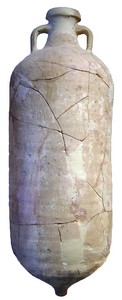Roman Amphorae: a digital resource
University of Southampton, 2005. (updated 2014) https://doi.org/10.5284/1028192. How to cite using this DOI
Data copyright © University of Southampton unless otherwise stated
This work is licensed under the ADS Terms of Use and Access.
Primary contact
Dr
David
Williams
Dept of Archaeology
University of Southampton
Avenue Campus
Highfield
Southampton
SO17 1BJ
England
Tel: 080 593032
Resource identifiers
- ADS Collection: 463
- DOI:https://doi.org/10.5284/1028192
- How to cite using this DOI
Keay 40

Courtesy of Museo Nacional de Arqueología Maritima, Cartagena
Marguerite Attree
Distinctive FeaturesOn the basis of five fragmentary examples, Keay (1984) describes this amphora in the following manner:The most characteristic had a wide shoulder and tall neck with gently concave sides. The rim had a pronounced outer face with semi-circular hollow beneath, and a gentle convex depression on the inner rim face. The handles were thickset with a squared profile and semi-circular section.The exterior of all samples was covered in an off-white to yellow slip. A complete example on display at Cartagena consists of a tall cylindrical body terminated by a rounded base with a poorly pronounced spike. See characteristics | ||
Date RangeFifth century AD?Search: [5th century AD] | ||
OriginThe fabric suggests a north African, perhaps Tunisian, origin.Search: [North Africa] [Tunisia] | ||
DistributionThinly distributed in the western Mediterranean.Search: [France] [Italy] [North Africa] [North West Europe] [Spain] [Western Mediterranean] | ||
ContentsUnknown, although olive oil is a possibility.Search: [Olive Oil] | ||
CommentsPrincipal contributor: Michel Bonifay |



 3D models
3D models


